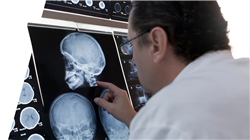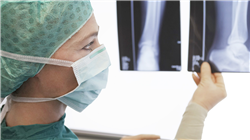University certificate
The world's largest faculty of medicine”
Introduction to the Program
Thanks to this 100% online Masters Degree, you will be able to interpret radiological images rigorously and discover findings of utmost importance for forensic investigations"

The advance of technology has had a great impact on Forensic Medicine, allowing practitioners to obtain significant data from sophisticated machinery such as Computed Tomography, Magnetic Resonance Imaging and Ultrasound. In this way, specialists have applied these procedures to autopsies to obtain detailed images of the internal structures of the human body. As a result, experts have been able to quickly detect injuries or abnormalities that have allowed findings to be thoroughly documented for legal purposes. However, these instruments can present a number of challenges due to the variability of clinical and pathological presentations.
Aware of this reality, TECH implements a revolutionary Masters Degree in Forensic Radiology that will allow professionals to overcome the challenges in this area and thus elevate their daily practice to a higher level. To achieve this, the academic itinerary will provide graduates with the keys to effectively handle the main diagnostic imaging tools (among which X-Ray systems, Ultrasound or MRI stand out). Additionally, the academic contents will delve into the skeleton of the human being at different stages of development.
In this way, specialists will have at their disposal the most effective resources for the detection of common traumatic injuries, such as fractures or dislocations. In addition, the program will include several case studies that will bring them closer to the methodologies used in forensic radiographs.
As for the methodology of this university program, it is taught in a convenient 100% online format, adapting to the needs of each student. It is also based on the innovative Relearningteaching system, of which TECH is a pioneer. This method consists of the reiteration of key concepts, ensuring that students consolidate their knowledge progressively. All this with the support of a teaching staff of international prestige, which will support you throughout your academic itinerary.
You will handle the most sophisticated radiological technology to identify human remains in cases of serious accidents, violent crimes and even natural disasters"
This Masters Degree in Forensic Radiology contains the most complete and up-to-date scientific program on the market. The most important features include:
- The development of practical cases presented by experts in Forensic Radiology
- The graphic, schematic and eminently practical contents with which it is conceived gather scientific and practical information on those disciplines that are indispensable for professional practice
- Practical exercises where self-assessment can be used to improve learning
- Its special emphasis on innovative methodologies
- Theoretical lessons, questions to the expert, debate forums on controversial topics, and individual reflection assignments
- Content that is accessible from any fixed or portable device with an Internet connection
Looking to specialize in Firearms and Explosives Trauma Radiology? Get it in as little as 12 months with this university program"
The program’s teaching staff includes professionals from the field who contribute their work experience to this educational program, as well as renowned specialists from leading societies and prestigious universities.
The multimedia content, developed with the latest educational technology, will provide the professional with situated and contextual learning, i.e., a simulated environment that will provide immersive education programmed to learn in real situations.
This program is designed around Problem-Based Learning, whereby the professional must try to solve the different professional practice situations that arise during the course. For this purpose, students will be assisted by an innovative interactive video system created by renowned and experienced experts.
You will delve into the use of Radiobiology Equipment to identify victims of radiation injuries"

With the Relearning methodology, you will update your knowledge from the comfort of your home and without the need to travel to an on-site academic center"
Why study at TECH?
TECH is the world’s largest online university. With an impressive catalog of more than 14,000 university programs available in 11 languages, it is positioned as a leader in employability, with a 99% job placement rate. In addition, it relies on an enormous faculty of more than 6,000 professors of the highest international renown.

Study at the world's largest online university and guarantee your professional success. The future starts at TECH”
The world’s best online university according to FORBES
The prestigious Forbes magazine, specialized in business and finance, has highlighted TECH as “the world's best online university” This is what they have recently stated in an article in their digital edition in which they echo the success story of this institution, “thanks to the academic offer it provides, the selection of its teaching staff, and an innovative learning method aimed at educating the professionals of the future”
A revolutionary study method, a cutting-edge faculty and a practical focus: the key to TECH's success.
The most complete study plans on the university scene
TECH offers the most complete study plans on the university scene, with syllabuses that cover fundamental concepts and, at the same time, the main scientific advances in their specific scientific areas. In addition, these programs are continuously being updated to guarantee students the academic vanguard and the most in-demand professional skills. In this way, the university's qualifications provide its graduates with a significant advantage to propel their careers to success.
TECH offers the most comprehensive and intensive study plans on the current university scene.
A world-class teaching staff
TECH's teaching staff is made up of more than 6,000 professors with the highest international recognition. Professors, researchers and top executives of multinational companies, including Isaiah Covington, performance coach of the Boston Celtics; Magda Romanska, principal investigator at Harvard MetaLAB; Ignacio Wistumba, chairman of the department of translational molecular pathology at MD Anderson Cancer Center; and D.W. Pine, creative director of TIME magazine, among others.
Internationally renowned experts, specialized in different branches of Health, Technology, Communication and Business, form part of the TECH faculty.
A unique learning method
TECH is the first university to use Relearning in all its programs. It is the best online learning methodology, accredited with international teaching quality certifications, provided by prestigious educational agencies. In addition, this disruptive educational model is complemented with the “Case Method”, thereby setting up a unique online teaching strategy. Innovative teaching resources are also implemented, including detailed videos, infographics and interactive summaries.
TECH combines Relearning and the Case Method in all its university programs to guarantee excellent theoretical and practical learning, studying whenever and wherever you want.
The world's largest online university
TECH is the world’s largest online university. We are the largest educational institution, with the best and widest online educational catalog, one hundred percent online and covering the vast majority of areas of knowledge. We offer a large selection of our own degrees and accredited online undergraduate and postgraduate degrees. In total, more than 14,000 university degrees, in eleven different languages, make us the largest educational largest in the world.
TECH has the world's most extensive catalog of academic and official programs, available in more than 11 languages.
Google Premier Partner
The American technology giant has awarded TECH the Google Google Premier Partner badge. This award, which is only available to 3% of the world's companies, highlights the efficient, flexible and tailored experience that this university provides to students. The recognition as a Google Premier Partner not only accredits the maximum rigor, performance and investment in TECH's digital infrastructures, but also places this university as one of the world's leading technology companies.
Google has positioned TECH in the top 3% of the world's most important technology companies by awarding it its Google Premier Partner badge.
The official online university of the NBA
TECH is the official online university of the NBA. Thanks to our agreement with the biggest league in basketball, we offer our students exclusive university programs, as well as a wide variety of educational resources focused on the business of the league and other areas of the sports industry. Each program is made up of a uniquely designed syllabus and features exceptional guest hosts: professionals with a distinguished sports background who will offer their expertise on the most relevant topics.
TECH has been selected by the NBA, the world's top basketball league, as its official online university.
The top-rated university by its students
Students have positioned TECH as the world's top-rated university on the main review websites, with a highest rating of 4.9 out of 5, obtained from more than 1,000 reviews. These results consolidate TECH as the benchmark university institution at an international level, reflecting the excellence and positive impact of its educational model.” reflecting the excellence and positive impact of its educational model.”
TECH is the world’s top-rated university by its students.
Leaders in employability
TECH has managed to become the leading university in employability. 99% of its students obtain jobs in the academic field they have studied, within one year of completing any of the university's programs. A similar number achieve immediate career enhancement. All this thanks to a study methodology that bases its effectiveness on the acquisition of practical skills, which are absolutely necessary for professional development.
99% of TECH graduates find a job within a year of completing their studies.
Master's Degree in Forensic Radiology
Immerse yourself in the fascinating world of forensic radiology and acquire the necessary skills to investigate and solve criminal and medico-legal cases with the Master's Degree developed by TECH Global University. This program, taught in online mode, will provide you with comprehensive and specialized qualification in the use of medical imaging technology to support judicial investigations and contribute to the justice system. Here, you will learn about the basic principles of medical radiology and how they are applied in the context of criminal and medico-legal investigation, including injury identification, fracture dating and accident reconstruction. You will also dive into the latest forensic imaging technology, covering radiography, computed tomography (CT), magnetic resonance imaging (MRI) and positron emission tomography (PET) to identify patterns and abnormalities that may be relevant to an investigation
Get qualified with a Master's Degree in Forensic Radiology
With this program, you will be prepared for an exciting and rewarding career in the field of forensic medicine and criminal investigation. You will develop specialized skills in medical image analysis and contribute to the solving of crimes and the administration of justice. As you progress through the program, you will discover the practical applications of forensic radiology in criminal investigation. You will learn how medical imaging can be used to establish cause of death, identify evidence of trauma, determine a person's identity and reconstruct events leading up to an injury or death. You will also learn how to work as a team with medical examiners, criminal investigators, attorneys and other experts to collect and analyze data, present findings and contribute to the resolution of cases. Finally, you will explore ethical issues and professional responsibility in forensic radiology, enabling you to handle confidential information ethically, respect patient privacy and comply with the ethical-legal standards established by the profession and the justice system. If you want to learn more, enroll now and take the first step towards a unique and exciting career.







